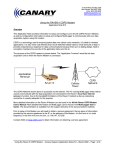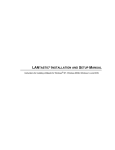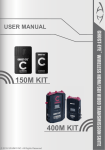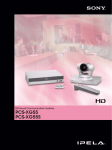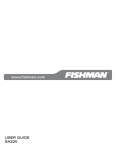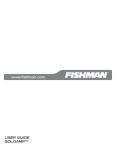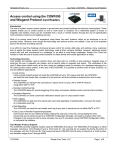Download Nikon F6 35mm SLR Camera
Transcript
Nikon F6 September 2004 Nikon F6 The flagship film SLR camera that seamlessly blends cutting-edge technologies and uncompromising craftsmanship Tokyo — Nikon Corporation is pleased to announce the introduction of the F6, the latest of the legendary F series cameras. The F6 is the sixth in the F series lineup, inaugurated with the Nikon F in 1959. The series evolved gradually, with the original Nikon F being followed by the F2 (1971), F3 (1980), F4 (1988) and the critically acclaimed F5 in 1996. Each of these cameras inherits select elements from its predecessors, including the legendary Nikon F mount, while offering the latest innovations to meet the increasingly diversified needs of professional photographers. A great number of Nikon F series cameras and Nikkor lenses are being put to the test day after day in various locations around the world — years, even decades, after their initial launch. The new Nikon F6 promises to uphold Nikon’s tradition of innovation and enduring value. The F6 includes the latest Nikon advances, such as the 11-area AF system for exceptionally highspeed autofocus operation with outstanding accuracy, and the Creative Lighting System for incomparable flash photography. And Nikon’s proprietary 3D Color Matrix Metering system has been refined for improved accuracy in scene reading. As you’d expect, the F6 satisfies the uncompromising standards of reliability that professionals command. An aluminum-alloy die-cast chassis; magnesium-alloy front body and covers (top, bottom); aluminum-alloy back body and camera back; strategically placed rubber surfaces; an easy-to-grip texture, and a self-diagnostic shutter that has undergone testing to assure accurate release up to and beyond 150,000 cycles, even in the most extreme environmental conditions. The F6 embodies the strength, rigidity and durability to perform wherever and whenever photographers need it. Furthermore, the F6 offers a variety of exciting, innovative control options such as a customizable function button, built-in data back functions and shooting data memory. You can also enjoy the convenience and versatility afforded by 41 Custom Settings which allow you to fine-tune the F6 to suit your individual shooting preferences and requirements. The new flagship film SLR also boasts a number of dedicated accessories. These include the Multi Power Battery Pack MB-40, interchangeable focusing screens (seven types), Data Reader MV-1 and camera cases. -1- Nikon F6 September 2004 Nikon F6 Feature Highlights High-precision shutter unit No shutter unit in any other camera comes close to matching the precision of the F6’s assembly. Created from cutting-edge materials — DuPontTM KEVLAR® and a special aluminum alloy — the blades of the shutter unit offer unparalleled reliability and are extremely lightweight, for lightning-quick movement. For enhanced accuracy, the movement of the blades is carefully analyzed using a high-speed video camera and computer simulations, enabling unprecedented precision even at shutter speeds of up to 1/8,000 second. DuPontTM and KEVLAR® are trademarks and registered trademarks of DuPont or its affiliates. Minimized operational sound and vibration Nikon engineers were so intent on subduing the camera’s operational sounds that they used a professional audio room to properly gauge their quality and frequency. The degree of vibration to which every part of the camera would be subjected was measured. This meticulous approach has resulted in a camera comprised of parts that have been highly refined for absolute minimum vibration, and frequency of movement attenuated to a level below that detectable by the human ear. Highly efficient mechanics The development of the F6 marks the first time 3D computer movement analysis has ever been applied to an SLR. This technique reveals the degree of power distributed to or generated by particular parts in specific directions. This made it possible for us to optimize the mechanical operation of the camera with fewer parts, leading to lower power consumption and higher durability Harsh environmental testing To ensure the camera could withstand the most severe conditions and environments, the F6 has been subjected to rigorous testing. The F6’s astonishing reliability is a function of our “right material for the right place” approach. Our engineers considered countless situations for camera use, then submitted the F6 to real-life testing to virtually guarantee exceptional dependability wherever and whenever photographers shoot. -2- Nikon F6 September 2004 Major Features Advanced Autofocus System • Multi-CAM 2000 Autofocus (AF) Sensor Module: The advanced high-speed, high-precision 11-area AF system with 9 cross-type AF sensors ensures quick response and sharp focus regardless of shooting conditions. • Four AF Area Modes: Single Area AF, Dynamic AF with Focus Tracking and Lock-on™, Closest Subject Priority Dynamic AF, Group Dynamic AF Advanced Exposure Metering System • 3D Color Matrix Metering with improved algorithm • Flexible Center-Weighted Metering • Spot Metering corresponds to the focus area selected Exposure Control • P, S, A, M, Flexible Program, Exposure Compensation, Auto Exposure/Flash Bracketing • Shutter speeds up to 1/8,000 sec. • Shutter speed and aperture control adjustable in 1/3 EV steps • Built-in Data Back functions • Customizable Function Button can be used to perform FV Lock, AE-L/AF-L, Flash Cancel or Metering operation. Creative Lighting System (with SB-800/600) • i-TTL Balanced Fill-Flash • Advanced Wireless Lighting capability • AUTO FP High-Speed Sync capability • FV (Flash Value) Lock • Slow Sync and Rear-Curtain Sync Stylish, High-durability Design • Exterior design by Giorgetto GIUGIARO* • Floating mechanisms ensure quiet operation • Aluminum-alloy die-cast chassis; magnesium-alloy front body and covers (top, bottom); aluminumalloy back body and camera back combine to optimize reliability -3- Nikon F6 September 2004 • Enhanced resistance to rain and dust • Self-diagnostic double-bladed shutter tested to 150,000 cycles supported by Nikon’s exclusive Shutter Monitor * Other important features • Four film advance modes: Single (S), Continuous Low-Speed (CL) for up to approx. 2 frames per second (fps), Continuous High-Speed (CH) for up to 5.5 fps (or 8 fps with optional Multi Power Battery Pack MB-40), and Continuous Silent (CS) for nearly silent operation at approximately 1 fps. • Electronically controlled depth-of-field preview function • Fast film rewind (9 seconds with 36-exp. film roll) • Manual film rewind • 41 Custom Settings • Nikon F mount • 10-pin remote terminal Dedicated Accessories • Interchangeable focusing screens • Multi Power Battery Pack MB-40 • Optional Data Reader MV-1 • Camera cases -4- Nikon F6 September 2004 Nikon F6 Specifications Type of camera: Integral-motor autofocus 35mm single-lens reflex with electronically controlled focalplane shutter Exposure modes: Programmed Auto (Flexible Program possible), Shutter-Priority Auto, AperturePriority Auto and Manual Picture format: 24 x 36mm (standard 35mm film format) Lens mount: Nikon F mount (with AF coupling, AF contacts) Lenses usable: G- or D-type AF Nikkor (except for DX- and IX-Nikkor): All functions available; PCMicro-Nikkor 85mm f/2.8D: All functions except autofocus and exposure modes other than Manual available without shifting and/or tilting the lens; AF Nikkor other than G-/D-type (except AF Nikkor for F3AF): All functions except 3D Color Matrix Metering and i-TTL flash control available; AI-P Nikkor: All functions except 3D Color Matrix Metering, i-TTL flash control and autofocus available; Non-CPU: Usable in Aperture-Priority Auto or Manual exposure mode, electronic rangefinder usable with lens having a maximum aperture of f/5.6 or faster, Color Matrix Metering, aperture value display, etc. usable with lens meeting specified criteria Viewfinder: Fixed eye-level pentaprism, built-in diopter adjustment (-2.0 to +1m-1), eyepiece shutter, eyepiece DK-17 (eyepiece lock available) Eyepoint: 18mm (at –1.0m-1) Focusing screen: B-type BriteView clear Matte screen II, interchangeable with six other optional focusing screens Viewfinder frame coverage: Approx. 100% Finder magnification: Approx. 0.74x with 50mm lens set to infinity and 1.0m-1 Viewfinder information: Focus indications, metering system, AE lock, FV lock, exposure mode, shutter speed lock, sync speed, shutter speed, aperture stop, aperture lock, aperture, multiple exposure, battery level, frame counter/exposure compensation value, electronic analog exposure display, exposure compensation, bracketing, ready-light, 11 sets of focus brackets Autofocus: TTL phase detection, Nikon Multi-CAM2000 autofocus module Autofocus detection range: Approx. EV –1 to EV 19 (ISO 100, at normal temperature) Focus modes: Single Servo AF, Continuous Servo AF, Manual Focus Tracking: Automatically activated in Single Servo AF or Continuous Servo AF Focus area: One — or a group — of 11 focus areas can be selected AF Area modes: Single Area AF, Dynamic AF, Group Dynamic AF or Dynamic AF with ClosestSubject Priority -5- Nikon F6 September 2004 Focus lock: Focus is locked by pressing AE/AF-L button or lightly pressing shutter release button in Single Servo AF Exposure metering: Three built-in exposure meters — 3D Color Matrix, Center-Weighted and Spot Metering range (ISO 100, f/1.4 lens): EV 0 - 20 in 3D Color Matrix and Center-Weighted, EV 2 – 20 in Spot Exposure compensation: With exposure compensation button; ±5 EV range, in 1/3, 1/2 or 1 steps Auto Exposure Bracketing: Number of shots: 2-7; compensation steps: 1/3, 1/2, 2/3, or 1 EV steps Auto Exposure Lock: Detected exposure value locked by pressing AE/AF-L button Film speed setting: DX or Manual selectable (manual setting has priority over DX detected film speed); DX: ISO 25-5000, Manual: ISO 6-6400 in 1/3 steps Shutter: Electronically controlled vertical-travel focal-plane shutter with built-in Shutter Monitor Shutter speeds: 30 to 1/8,000s (1/3 steps in S and M modes); Bulb setting available in M mode (Shutter speed can be prolonged to 30 minutes in M mode) Accessory shoe: ISO518 hot-shoe contact digital data communication (sync contact, ready-light contact, TTL auto flash contact, monitor contact, GND), safety lock provided Sync contact: X-contact only; flash synchronization up to 1/250s (up to 1/8,000s possible in AUTO FP High-Speed Sync) Flash control TTL flash control by combined five-segment TTL Multi Sensor with single-component IC and 1,005-pixel RGB sensor; i-TTL Balanced Fill-Flash with SB-800/600; Film speed range in TTL auto flash: ISO 25-1000 Flash sync modes: Front-curtain sync (normal sync), Red-Eye Reduction, Red-Eye Reduction with Slow Sync, Slow Sync, Rear-Curtain Sync Flash ready-light: Lights up when the compatible Nikon Speedlight attached is fully charged; Blinks (3 seconds after flash) for full output warning Sync terminal: ISO519 terminal, lock screw provided Creative Lighting System: Advanced Wireless Lighting, AUTO FP High-Speed Sync, Modeling flash, FV Lock and Wide Area AF-Assist Illuminator available with SB-800/600 Speedlights Self-timer: Electronically controlled; timer duration: 10 seconds Depth-of-field preview button: Press to stop-down lens aperture Mirror lockup: Set using film advance mode selector Film loading: Film automatically advances to first frame when camera back is closed Film advance modes: Automatic advance with built-in motor; three modes available (S: One-frame advance, CL: Continuous low-speed shooting, CH: Continuous high-speed shooting, CS: Continuous silent-low-speed shooting) -6- Nikon F6 September 2004 Film advance speed: (With Continuous Servo AF (C), Manual exposure mode, shutter speed of 1/250s or faster, 36-exposure film, CR123A-type lithium batteries [AA-size alkaline-manganese or Rechargeable Li-ion Battery EN-EL4 in Multi Power Battery Pack MB-40]) CL: Approx. 2 fps [4 fps]; CH: Approx 5.5 fps [8 fps]; CS: Approx. 1 fps [2 fps] Film rewind: Choice of automatic or manual; automatically rewinds at the end of film roll or when two film rewind buttons are pressed; Rewind speed with 36-exposure film: Approx. 7 seconds (12 seconds in CS mode) Multiple exposure: Activated via shooting menu Interval timer: Activated via shooting menu Top LCD panel information: Shutter speed lock, sync speed, shutter speed, aperture stop, aperture lock, aperture, Auto Exposure Bracketing, exposure mode, Flexible Program, exposure compensation, electronic analog exposure display, battery power, exposure compensation value, Auto Exposure Bracketing status, frame counter Rear LCD panel information: Shooting display (Normal, detailed, full display); Shooting data display (film data, frame data); Menu display (Custom Setting menu, set up menu, shooting menu, Non-CPU lens, language) Data imprint: Activated via shooting menu; in-frame, between-frame and 0-frame imprint possible: film speed range: ISO 50 – 3200 (DX) Internal clock: Built-in clock; 24-hour; leap year adjustment until 2099 Camera back: Hinged back; film confirmation window, AF area mode selector, multi-selector, MENU button, film speed (ISO) button, flash sync mode button, INFO button, rear LCD panel, built-in data imprint unit Shooting data: Recordable number of film rolls (36 exposures): Approx. 57 rolls in basic shooting data (13 items), Approx. 31 rolls in detailed shooting data (21 items) 10-pin remote terminal: Equipped Power source: Battery holder MS-41 provided (two 3V lithium batteries); optional Multi Power Battery Pack MB-40 and AA-type battery holder MS-40 available (for eight alkaline-manganese, lithium or NiMH batteries, or one Rechargeable Li-ion Battery EN-EL4 [with optional Battery Chamber Cover BL3]); built-in backup battery for internal clock Power switch: Power ON, OFF and LCD panel illuminator Exposure meter: Auto meter shut-off 8 seconds after power turned on if no operations are performed; activated by lightly pressing shutter release button or pressing AF start button after power is turned on Battery power confirmation: for sufficient power; -7- indicates batteries are beginning to lose Nikon F6 September 2004 power; indicates batteries are just about exhausted, prepare fresh batteries; blinking indicates replacement of batteries is necessary (shutter locks and rear LCD indications disappear) Number of film rolls per set of fresh batteries (Approx.): Usable number of 36-exposure film rolls per set of fresh batteries (Approx.): The usable number of film rolls was tested under the following conditions by Nikon. Test 1 Using an AF-S VR 24-120mm f/3.5-5.6G IF-ED lens, Vibration Reduction function on, in Continuous Servo AF with film advance mode at S and shutter speed of 1/250 second. After lightly pressing the shutter release button for 8 seconds, autofocus operation covers the full range from infinity (∞) to the closest distance and back to infinity (∞) before each shot. After the exposure meter automatically turns off, the same operation follows for the next shot. Battery/Temperature 20˚C (68˚F) –10˚C (14˚F) CR123A 3V lithium 15 6 LR6/AA-size alkaline (with MB-40) 10 1 R6/AA-size Ni-MH (with MB-40) 30 30 FR6/AA-size lithium (with MB-40) 45 35 Rechargeable Li-ion EN-EL4 (with MB-40) 35 25 Test 2 Using an AF-S VR 70-200mm f/2.8G IF-ED lens, Vibration Reduction function on, in Continuous Servo AF with film advance mode at CH and shutter speed of 1/250 second. After lightly pressing the shutter release button for 3 seconds, autofocus operation covers the full range from infinity (∞) to the closest distance and back to infinity (∞) three times before each shot. The same operation follows for the next shot. Battery/Temperature 20˚C (68˚F) –10˚C (14˚F) CR123A 3V lithium 35 15 LR6/AA-size alkaline (with MB-40) 55 4 R6/AA-size Ni-MH (with MB-40) 55 50 R6/AA-size lithium (with MB-40) 95 70 Rechargeable Li-ion EN-EL4 (with MB-40) 65 50 Duration of Long Time (Bulb) exposure (Approx.): Battery/Temperature 20˚C (68˚F) CR123A 3V lithium 5 hours LR6/AA-size alkaline (with MB-40) 6 hours R6/AA-size Ni-MH (with MB-40) 5 hours FR6/AA-size lithium (with MB-40) 8.5 hours Rechargeable Li-ion EN-EL4 (with MB-40) 7 hours Tripod socket: 1/4 (ISO1222) -8- –10˚C (14˚F) 3 hours 1.5 hours 4 hours 7 hours 6 hours Nikon F6 September 2004 Custom Settings: 41 Custom Settings are available Two-Button Reset: Pressing the MENU and INFO buttons simultaneously and holding them for more than 2 seconds resets various settings to their original default settings (with some exceptions) Dimensions (W x H x D): Approx. 157 x 119 x 78.5mm (6.2 x 4.7 x 3.1 in.) Weight (without batteries): Approx. 975g (34.4 oz.) All specifications apply when fresh batteries are used at normal temperature (20°C/68°F) under test conditions established by Nikon. Specifications and design are subject to change without any notice or obligation on the part of the manufacturer. -9-











